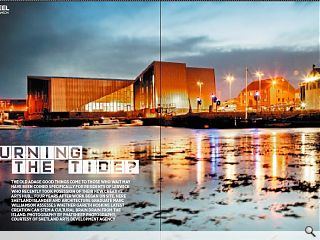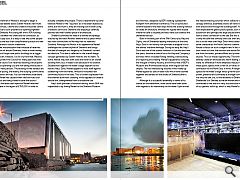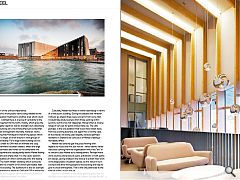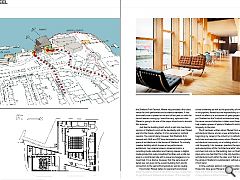Mareel
6 Aug 2013
The old adage good things come to those who wait may have been coined specifically for residents of Lerwick who recently took possession of their new creative arts hub... Four years after work began on site. Here Shetland islander and architecture graduate Marc Williamson assesses whether Gareth Hoskins latest creation can stem a cultural brain drain from the island. Photography by Phatsheep Photography, courtesy of Shetland Arts Development Agency.
The slightest mention of Mareel is enough to begin a strongly worded debate about Gareth Hoskins new multi million pound music, cinema and creative industries centre in Shetland. Due to such problems as opening eighteen months late; Shetland Arts being left with a 10% funding gap; lawsuits between the client and the contractor, as well as council pay outs, it is easy to see why some people within the isles are less than complImentary about this new addition to Lerwick’s historic waterfront.There is the misconception that because of reserves generated from oil around Shetland, there is more money available to build large scale public buildings on a bigger budget. The truth, however, is a far cry from that. Massive overspending within the Council for many years has now resulted in the council’s oil reserves reaching critical point. This said, strict spending cuts are now being introduced in the isles over many sectors. Those being hit the hardest are services to the young, the elderly, the outlying communities and the education services. You can therefore understand the outrage Mareel has caused when vital services such as rural schools are being closed to save the council money, when the latest cash injection Mareel received was somewhere in the region of £750,000 in order to actually complete the project. There is resentment by some towards Mareel or the “big shed” as it has been dubbed by some, but the truth is, they are missing out on both using a fantastic service to Shetland and enjoying a carefully planned and well-crafted piece of architecture.
Shetland connotes the idea of a remote archipelago scoured by the harsh Atlantic weather and a place which has more connections to Norway than to mainland Scotland. Although not Nordic in its appearance Mareel challenges the current skyline of Shetland and brings the idea of strength and longevity to Shetland’s current architecture. This idea is reflected in the overall design concept generated by Gareth Hoskins and his team. To some, Mareel may look both bold and harsh as an overall building form, but, it needs to be because of its location. Situated hard against the water’s edge adjacent to the historic Hay’s Dock, Mareel appears to hold itself against a battering from the waves, wind and horizontal rain commonly found in the isles. This is further expressed from the external aluminium cladding, which appears to create a secure skin, strengthened from its excessive use.
Hay’s dock provides a historical setting, which GHA has responded to by linking Mareel to the Shetland Museum and Archives, designed by BDP, creating a pedestrian footpath from entrance to entrance. The un-punctured cinema façade to the west helps frame the existing harbour to create an enclosure, whereas the ripped west façade where the café is situated provides views out towards the sheltered harbour.
Built in the early part of the 19th Century by Hay and Ogilvy, one of Shetlands leading merchants of the time, Hay’s Dock’s rich history now provides a tangible link to the islands’ maritime heritage. During its early life, Hay’s Dock was one of the busiest harbours in Lerwick and over the years, became a central focus for Hay and Company’s activities which included fishing, whaling, boat building and repairing and trading. Mareel’s appearance conjures the thought of heavy industry, and mimics that of BDP’s Museum and Archives boat house, with angular sail-like shapes. The two intersecting volumes which make up Mareel appear as sails or boat hulls which have crashed together and landed on the shores of Shetland after a storm.
Although it is successful externally in terms of its stance on the waterfront, more could have been done with regards to its relationship to the water. Upon arrival the interconnecting volumes which collide to create a canopy entrance, essentially blocks all views to the water, both around and through the building itself. You may have expected the grand public spaces, such as the café, auditorium and perhaps the large double entrance hall to have a direct connection to the sea. But this is sadly lost. It is only the café that directly looks out over any water, but this is to the west over Hays Dock which does not have the same character as the North Sea and it seems obvious and forced to focus on such a staged view. In fact some of the best views out over the harbour and across Bressay sound are from the toilets, private offices and private recording studios. This is a missed opportunity. The timber interiors already create an enclosed and warm feeling, so it would make no difference if more emphasis was put into designing these public spaces with a view of, or have a direct connection to the North Sea, in mind. Arranging these spaces to the water’s edge would give the building a greater power, presence and ultimately a stronger connection to not only the site, but, to the residents of Shetland overall. Shetlander’s or Shelties as we are known are intrinsically connected to the sea on a very subconscious level. It is part of our genetic build-up, which is why Mareel’s relationship to the water if of the utmost importance.
In addition to more public views being needed to the north, the elevation treatment is another area which could be improved. Granted there is a sense of verticality to the window arrangement to the north, mostly, which gives the exterior a greater depth as well as strength, but collectively as an entire building skin, the whole effect jars somewhat.
The spatial arrangement internally, however, works well in creating free-flowing and welcoming spaces which people want to linger or stroll around in with groups of friends or individually. For a large scale building such as Mareel, it is a credit to GHA that an intimate and cosy internal environment has been created, where the large scale public corridors and voids do not overpower the interior atmosphere and subsequently leaves Mareel feeling like a cold, dark and empty shell. It is the clever position of the main auditorium which continually links this feeling throughout. The warm timber cladding which surrounds the space is akin to a hearth or fire which permeates heat throughout the building. The auditorium is also an example of the keen attention to detail by GHA and PJP in delivering an acoustically sound space, which showcases Shetland’s vast musical talent and ability to its best.
Culturally, Mareel has fitted in rather seamlessly in terms of a new public building. During the debate over whether it should go ahead, there were concerns from some that it would take away business from those existing within Lerwick, but this has not happened. Mareel offers a diverse range of services for public and private use. The café perhaps, is the only addition that would have taken away from any existing business, but again this is not the case, all businesses are being used equally, because perhaps residents in Shetland are conscious of Mareel creating a monopoly effect.
Mareel has certainly got the juices flowing with regards to music and film, but not art - which seems rather ridiculous coming from the organisation which has “art” in its title and uses Mareel as its headquarters. Perhaps more work could be done around public exhibitions or with public art classes, giving amateurs the chance to exhibit their work in the large public circulation spaces, as this would in turn connect and draw more people to the building and help to give it a local atmosphere. That is the only downside to the trifecta of film, music and art.
Tourism in Shetland is only really getting going now. For the likes of such key events as the Lerwick Up Helly Aa and the Shetland Folk Festival, Mareel has provided a first class venue for both performers and audience members. It has done well since it opened at the end of last year, so with the tourist season coming up I would be very optimistic that Mareel is going to be one of the major attractions to tourists this summer.
Just like the building itself, which is split into two forms, opinion in Shetland is and will be decidedly split over Mareel well into the future, whether it is for personal or political reasons. You cannot deny, however, that Shetland Arts teamed with GHA and PJP have delivered an accomplished piece of architecture to the shores of Shetland. To actually create a building which houses a live performance auditorium, two cinema screens, rehearsal rooms, a recording studio, education and training spaces, a digital media production suite, broadcast facilities and a cafe bar area in a constrained site with a power and elegance is no mean feat. It is a shame, however, that the same level of detail was not given to the overall building form and its connection to the sea both physically as well as visually.
If and when Mareel defies its opponents and shows those the positive impact it has within the isles, maybe then its significance to Shetland will be known. With a new high school underway as well as the possibility of new hospital in the pipeline, Mareel has the responsibility to create a knock on effect to a succession of great projects, to help put Shetland on the Scottish architectural map. Let’s hope the same care and attention is taken over these projects to help create a power of place in Shetland’s architecture and longevity to the isles.
Much has been written about Mareel from an architectural stance, and as a new architecture graduate beginning my career in the industry it is refreshing to both hear and read discussions about Mareel within the architectural community on a building which I use and visit frequently. I do, however, question the opinions and assumptions of the “architectural elite” who openly comment not only on the building, but, on Shetland as a place who now feel that this is the only building with any architectural merit within the isles, and, that architecture on the whole in Shetland is substandard, without experiencing it first-hand.
In time, perhaps opinions will begin to change and those who have given Mareel a frosty reception will begin to thaw, but much like the Shetland weather, its residents are strong-willed and difficult to break.
|
|
Read next: Engineering Survey
Read previous: Fountainbridge
Back to August 2013
Browse Features Archive
Search
News
For more news from the industry visit our News section.
Features & Reports
For more information from the industry visit our Features & Reports section.






